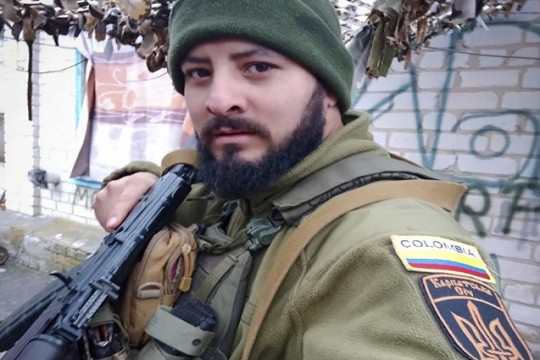A 32-year-old professional soldier from Medellín, Colombia who goes by the call sign Checho shows him in his combat gear in Donbas, eastern Ukraine.
Photo: AP
Melodic Colombian Spanish fills a hospital treating soldiers wounded fighting Russian forces in eastern Ukraine. Colombians have been joining Ukraine’s army as it seeks to attract Spanish-speaking soldiers to replenish its ranks, AP news informs.
A 32-year-old from the city of Medellin was trying to save a colleague wounded in three days of heavy fighting with Russian forces. Russian drones attacked the group and shrapnel from a grenade dropped by one pierced his jawbone.
“We got up and decided to run away from the position to save our lives,” Checho said. “There was nowhere to hide.”
With a military of 250,000, Colombia has Latin America’s second-largest army, after Brazil’s. More than 10,000 retire each year. And hundreds are heading to fight in Ukraine, where many make four times as much as experienced non-commissioned officers earn in Colombia, or even more.
“Colombia has a large army with highly trained personnel but the pay isn’t great when you compare it to other militaries,” said Andrés Macías of Bogota’s Externado University, who studies Colombian work for military contractors around the world.
Retired Colombian soldiers began to head overseas in the early 2000s to work for U.S. military contractors protecting infrastructure including oil wells in Iraq. Retired members of Colombia’s military have also been hired as trainers in the United Arab Emirates and joined in Yemen’s battle against Iran-backed Houthi rebels.
Colombia’s role as a recruiting ground for the global security industry also has its murkier, mercenary corners: Two Colombians were killed and 18 were arrested after they were accused of taking part in the assassination of Haitian President Jovenel Moïse.
At the military hospital normally treating wounded Ukrainian soldiers, a group of about 50 Colombian fighters spend most of their time staring at their phone screens — calling home, browsing the internet and listening to music in between meals and medical procedures, most for light injuries.
In early 2022, authorities said 20,000 people from 52 countries were in Ukraine. Now, in keeping with the secrecy surrounding any military numbers, authorities will not say how many are on the battlefield but they do say fighters’ profile has changed.
The first waves of volunteers came mostly from post-Soviet or English-speaking countries. Speaking Russian or English made it easier for them to integrate into Ukraine’s military, Shahuri said.
Last year the military developed an infrastructure of Spanish-speaking recruiters, instructors and junior operational officers, he added.
Hector Bernal, a retired ex-combat medic who runs a center for tactical medicine outside Bogota, says that in the last eight months he’s trained more than 20 Colombians who went on to fight in Ukraine.
Checho says principle drove him to travel to Kyiv last September. He estimates that in his unit alone, there were around 100 other fighters from Colombia who had made the same journey.
In Colombia, word about recruitment to the Ukrainian army spreads mostly through social media. Some of the volunteers who already fight in Ukraine share insights on the recruitment process on platforms such as TikTok or WhatsApp.
After almost three weeks in the hospital, Checho has returned to Ukraine’s front line. So have more than 50 other Colombian fighters who were treated in the same facility.
“The situation here is hard,” Checho told AP. “We are under constant bombardment, but we will keep fighting.”
read more in our Telegram-channel https://t.me/The_International_Affairs

 10:08 11.02.2024 •
10:08 11.02.2024 •























